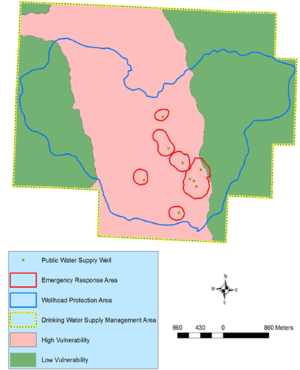
Guidance and recommendations for conducting a higher level of engineering review for stormwater infiltration in DWSMAs and Wellhead Protection Areas Revision as of 19:15, 31 July 2018 by Mtrojan (talk | contribs) (→Description of Emergency Response Areas, DWSMAs, and vulnerability of DWSMAs)
This page is in development
The Construction Stormwater Permit requires a higher level on engineering review for proposed infiltration projects in areas overlying an Emergency Response Area (ERA) where the vulnerability of the DWSMA (Drinking Water Supply Management Area) is classified as moderate, or in areas outside the ERA where the vulnerability of the DWSMA (Drinking Water Supply Management Area) is classified as high or very high. This page provide guidance and recommendations for conducting a higher level of engineering review.
Contents
- 1 Description of Emergency Response Areas, DWSMAs, and vulnerability of DWSMAs
- 2 Rationale for requiring a higher level of engineering review
- 3 Summary of infiltration restrictions in the Construction Stormwater General Permit
- 4 Guidance and recommendations for conducting a higher level of engineering review
- 5 Examples
Description of Emergency Response Areas, DWSMAs, and vulnerability of DWSMAs
The figure at the right illustrates protection designations used to manage public water supply wells that have wellhead protection plans.
- Drinking Water Supply Management Area (DWSMA) - the surface and subsurface area surrounding a public water supply well, including the wellhead protection area, that must be managed by the entity identified in a wellhead protection plan. This area is delineated using identifiable landmarks that reflect the scientifically calculated wellhead protection area boundaries as closely as possible.
- Drinking Water Supply Management Area Vulnerability. An assessment of the likelihood that the aquifer within the DWSMA is subject to impact from overlying land and water uses. It is based upon criteria that are specified under Minnesota Rules, part 4720.5210, subpart 3.
- Emergency Response Area (ERA). The part of the wellhead protection area that is defined by a one-year time of travel within the aquifer that is used by the public water supply well (Minnesota Rules, part 4720.5250, subpart 3). It is used to set priorities for managing potential contamination sources within the DWSMA. This area is particularly relevant for assessing impacts from potential sources of pathogen contamination because this time of travel is believed to closely correspond with the survival period of many pathogens.
- Wellhead Protection Area (WHPA) – the surface and subsurface area surrounding a well or well field that supplies a public water system, through which contaminants are likely to move toward and reach the well or well field (Minnesota Statutes, section 103I.005, subdivision 24).
A public water supply well is vulnerable if:
- the well water contains ten (10) milligrams per liter or more nitrate plus nitrite nitrogen;
- the well water contains quantifiable levels of pathogens as defined in part 7040.0100, subpart 26, or chemical compounds that indicate groundwater degradation as defined in Minnesota Statutes, section 103H.005, subdivision 6;
- the well water contains one tritium unit or more when measured with an enriched tritium detection method; or
- an enriched tritium analysis of the well water has not been performed within the past ten years; and
- information on the well construction is not available; or
- the geological material from the land surface to where the groundwater enters the public water supply well is:
- fractured bedrock;
- solution weathered bedrock;
- sandstone bedrock;
- unconsolidated material 0.062 millimeters (fine sand) or larger; or
- a combination of the materials specified in units (a) to (d).
Five classes of vulnerability exist: very low, low, moderate, high, and very high. Within high and very high vulnerability designations, contaminants at the land surface have the potential to move quickly to the underlying aquifer.
Rationale for requiring a higher level of engineering review
Summary of infiltration restrictions in the Construction Stormwater General Permit
Guidance and recommendations for conducting a higher level of engineering review
- Identify hotspots
- Conduct a hydrogeologic assessment of the proposed location
- Evaluate future land use in the area contributing to the proposed infiltration practice
